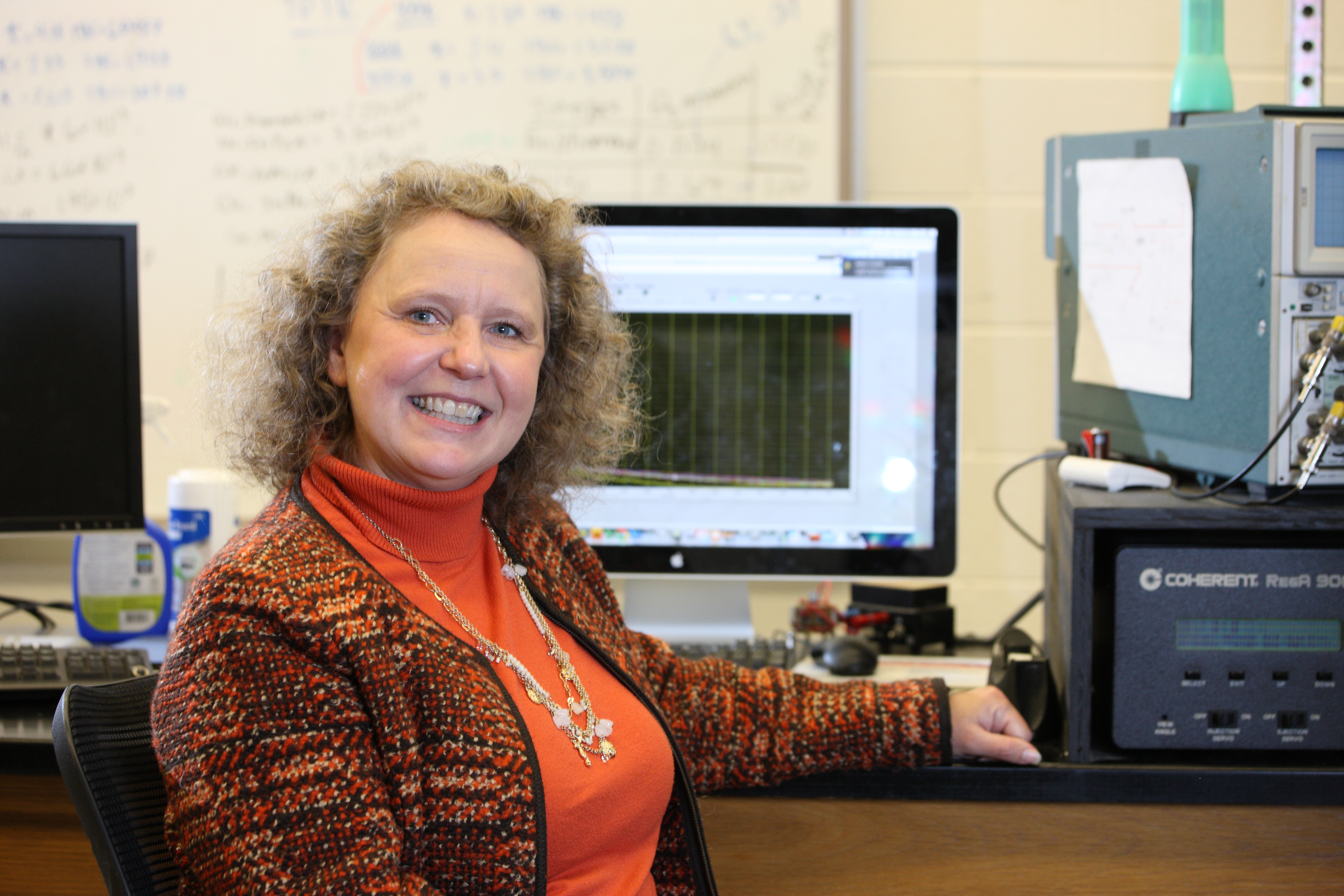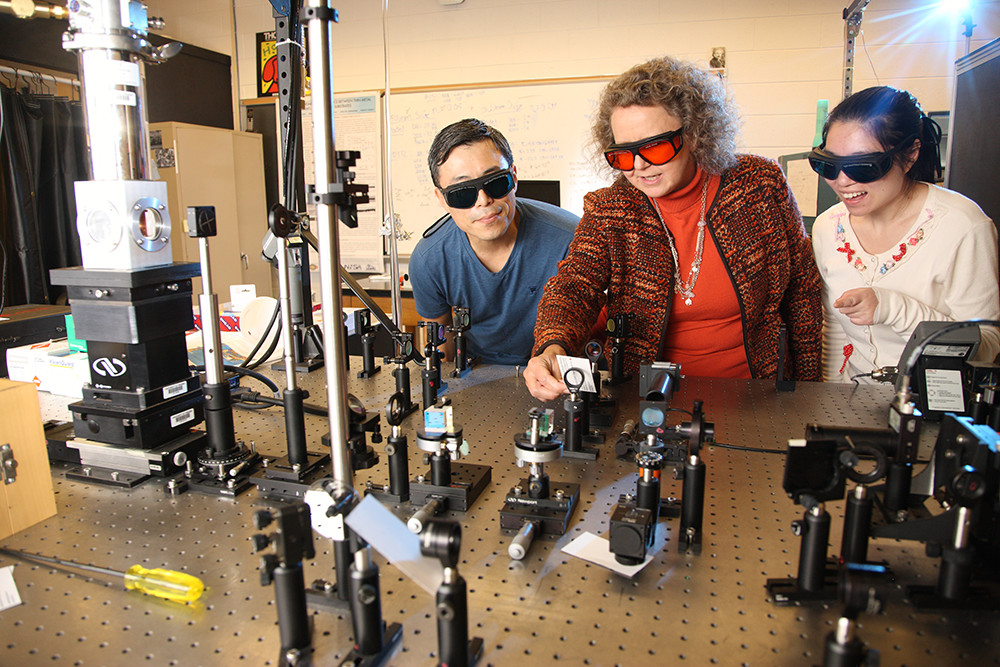Professor Pamela Norris remembers the moment when she truly realized engineering can make the difference between life and death.
She was sitting with a group of military officers at the Pentagon about 15 years ago, explaining how her research could help in detecting biological warfare agents. Norris’ lab at the University of Virginia had developed “smart aerogels” that could trap and identify biological agents.
Norris’ aerogels resemble smoke or smog turned into solids. But they are structurally advanced materials, made up of 99.9 percent air and 0.1 percent silicon dioxide. The silicon dioxide molecules are strung together in such a circuitous way that gas and heat have a torturous path getting through. When certain receptors are mixed with the aerogels, biological agents easily get stuck and form strong bonds, which can then be detected.
In chaotic, war-torn parts of the world, the officers said, soldiers and civilians could be saved by Norris’ research.
The opportunity to make such a profound difference is what drew Norris to engineering, and it’s what has driven her to become one of the most productive researchers and faculty members, by almost any measure, at UVA’s School of Engineering and Applied Science.
Since she became the first person in her family to attend college, she has founded two research laboratories, secured three patents (two more are pending) and drawn more than $25 million worth of research grants to UVA. She is a fellow of the American Society of Mechanical Engineers. She has also consistently advised one of the largest research groups in the Engineering School. Six of her students earned their Ph.D.s last academic year, believed to be the largest number ever for an engineering professor.
Norris is a champion for engaging women in engineering, and is a co-principal investigator for UVA’s National Science Foundation ADVANCE Institutional Transformation Award grant aimed at increasing the participation and advancement of women faculty members in science and engineering.

Pamela Norris
“Pam embodies our vision for the School of Engineering,” Benson said. “She is an extraordinarily accomplished researcher who will help our faculty focus their efforts on interdisciplinary research that can truly make a difference in the world. At the same time, she is an outstanding mentor and role model for faculty and students. Her talents and leadership will position UVA Engineering to move to the next level.”
Benson has set a goal of doubling the research funds the school receives each year from grants and corporate partners. He also wants to increase the average research funding individual faculty members receive, and focus on interdisciplinary research opportunities, such as a recent initiative to hire eight new faculty members spanning five departments and working together in a collaborative research laboratory in the area of cyber-physical systems.
Norris has the leadership skills and research experience to help the school achieve those ambitious goals, Benson said.
Eric Loth, who chairs the Department of Mechanical and Aerospace Engineering, agreed. “Professor Pam Norris is perhaps the most distinguished faculty member in the history of the Department of Mechanical and Aerospace Engineering,” Loth wrote in an email. “She has an incredible record of research excellence, as evidenced by her leadership of the largest Multidisciplinary University Research Initiative ever housed in the MAE department ($7.5M) and more than $25 million in external research at the University of Virginia. She has a Google Scholar h-Index of 33, an incredibly high ranking of worldwide scholarly impact,” that measures both the number of papers a scientist publishes and the number of citations the scientist receives for the papers.
“Moreover, she is dedicated to sharing her experience with School of Engineering junior and senior faculty, who see and respect her as a role model for engineering excellence and university leadership.” .
A Research Powerhouse
Norris launched her career by offering to work as a postdoctoral researcher – for free – under then-University of California at Berkley Chancellor Chang-Lin Tien, founder of the field of microscale heat transfer. He was so impressed with her drive, he hired her to conduct experiments and analysis of heat transfer in aerogels and to oversee research activities in his lab. “It totally changed my career,” she said.
When the postdoctoral appointment ended, she accepted a position in 1994 as an assistant professor at UVA, and quickly made a mark.
During her first year, she landed a National Science Foundation CAREER award, a prestigious award given to support the early career-development activities of faculty who effectively support their schools’ missions by integrating research and education. Through that process, she received funding to start her first lab, the Nanoscale Energy Transfer Laboratory.
She needed aerogels for her heat transfer research work, and aerogels were incredibly expensive, so she decided to make them herself. A grant from the Defense Advanced Research Projects Agency allowed her to found her own Aerogel Research Laboratory, which led to the discovery of ways to use aerogels to detect biological warfare agents.
Although that line of research tapered off a few years after the Sept. 11 terrorist attacks, which led the Department of Defense to move its biological warfare-detection research efforts to national labs, Norris has continued mission-critical work with the military. A $7.5 million grant from the Office of Naval Research focused on the basic science of heat transfer in the multi-scale systems aboard warships, a project she affectionately calls “chip-to-ship” thermal management. She also partnered with materials science professor Haydn Wadley and mechanical and aerospace engineering colleague Hossein Haj-Hariri to design a patented high-performance jet blast protector for aircraft carriers.
Norris earned promotion to full professor in 2004, and was named Frederick Tracy Morse Professor in 2010.
“Pam has a unique ability to see the big picture (bigger than most can see), and at the same time note the minutest of details,” said Haj-Hariri, who chaired the Mechanical and Aerospace Engineering department before recently accepting a post as dean of the College of Engineering and Computing at the University of South Carolina. “Her level of organization is second to none.”
Creating Opportunities for Others
Ask her what she is most proud of, however, and Norris is very clear: Her biggest accomplishment is mentoring undergraduate and graduate students and fellow faculty members. She has supervised 23 doctoral students and 26 master’s degree students in her research labs, as well as a long list of undergraduate research assistants.
“What I like to do is help people succeed beyond what they think they are capable of doing,” she said. “I like to help remove barriers and open up opportunities for them.”
John Hostetler was Norris’ first Ph.D. student. He started out planning just to get a master’s degree, and adamantly refused to engage in any public speaking.
“I told Pam at the time, ‘I’m not doing it.’ She said, ‘Yes, you are!’” he recalled. “Well, Pam won, and not only got me over my stage fright, but helped me to develop a strong sense of confidence – not only about my research, but my ability to present technology and science in a meaningful way.”
Hostetler continued his research and earned his Ph.D. with Norris, along the way receiving the University’s annual Allan Talbott Gwathmey Memorial Award for excellence in research. He is now director of R&D Wafer Fabrication at New Jersey-based United Silicon Carbide Inc., and his work recently earned a 2015 R&D 100 Award.
“I always say that deciding to work for Pam was the second-best decision I have made in my life, the first being my marriage,” he said.
She instills self-motivation and engagement in her students, Hostetler said, while also managing big, collaborative projects.
“Pam’s unique ability to network and solicit research opportunities is her biggest asset to the University. If the first 10 ideas don’t work, come up with 10 more, present them clearly, and start on your next 10 while waiting for funding. This is her approach,” he said.
Patrick Hopkins, an associate professor of mechanical and aerospace engineering, said he was captivated by Norris’ interdisciplinary research when he was a UVA undergraduate and Norris was discussing her work as a guest lecturer in one of his classes.
He joined her lab while earning his Ph.D. and credits Norris with giving him the best career advice he’s ever received. As he neared graduation, he had offers to join the faculties of various universities, which was what he ultimately wanted to do. He also had an offer for a prestigious Harry S. Truman Postdoctoral Fellowship at Sandia National Laboratories.
“At that point in your life, you are tunnel-visioned on earning your Ph.D., so it’s hard to evaluate what road to take,” he said. “You’re just excited to start your life and do your own research work. You don’t think about the implications.
“She knew all of this. She also didn’t tell me what to do. She just gave me really good advice and additional data so that I could make the decision for myself.”
She told him that the faculty offers on the table were good, but after a postdoctoral position at a national lab, he could potentially land his dream job. Hopkins decided to accept the Truman Fellowship at Sandia, and then later applied for a position at UVA.
“I always hoped that I’d be able to come back to UVA, but just thought it would be much later in life,” he said. “However, I really got my dream job at a young age, and that was all due to Pam’s advice.”
During her term as associate dean for research and graduate studies – a position Norris held for the previous four years – she designed and led a teaching internship program for engineering doctoral students in which the students are paired with professors for a semester to learn about teaching on the college level. It is the kind of experience that future teachers in elementary, middle and high schools routinely get, but had not typically been offered to future professors. She credits her participation in a similar program at Georgia Tech with jumpstarting her own teaching career.
Norris also founded and led a peer-mentoring group for assistant professors to support them in their new careers. Her mentoring work earned her the Undergraduate Research Network Faculty Award for Mentorship in both 2006 and 2007.
Haj-Hariri said her passion for educating faculty and staff about the value of diversity of all types, including gender, race and thought, has helped the Engineering School grow. Thirty-two percent of UVA’s undergraduate engineering students are female – above the national average of 25 percent – and 26 percent of the doctoral degrees awarded in 2014 went to women. According to the American Society for Engineering Education, which annually surveys U.S. engineering schools, this ranks UVA 14th out of 124 U.S. universities that awarded 25 or more engineering doctorates that year.
In her new role as executive associate dean for research, Norris will bring her skills as a mentor and role model as she works with faculty to build strong, productive, interdisciplinary research efforts.
“The challenges facing the world right now require creative solutions,” she said. “The most creative solutions come from diverse people working together and bringing their talents and experiences to bear.”
Hopkins said students and faculty members know that Norris has their best interests and the interests of the school at heart.
“She knows how people succeed and how they might link up with each other, and she knows that at all levels – the graduate student level, the department level and the school level. Her ability to relate has already made her extremely unique. You really couldn’t ask for a better person to provide direction, guidance and leadership.”
Media Contact
Article Information
December 2, 2015
/content/professor-makes-difference-lives-soldiers-students-and-colleagues

